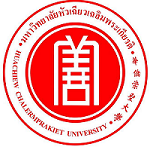Please use this identifier to cite or link to this item:
https://has.hcu.ac.th/jspui/handle/123456789/779Full metadata record
| DC Field | Value | Language |
|---|---|---|
| dc.contributor.advisor | 肖瑜 | - |
| dc.contributor.advisor | Xiao, Yu | - |
| dc.contributor.author | 唐心迎 | - |
| dc.contributor.author | Tang, Xinying | - |
| dc.contributor.other | Huachiew Chalermprakiet University. College of Chinese Studies | - |
| dc.date.accessioned | 2022-10-08T11:31:33Z | - |
| dc.date.available | 2022-10-08T11:31:33Z | - |
| dc.date.issued | 2019 | - |
| dc.identifier.uri | https://has.hcu.ac.th/jspui/handle/123456789/779 | - |
| dc.description | Thesis (M.A.) (Teaching Chinese) -- Huachiew Chalermprakiet University, 2019 | th |
| dc.description.abstract | คำลักษณะนาม classifier เป็นคำศัพท์ที่ถูกกล่าวขึ้นภายใต้การวิจัยโครงสร้างการแบ่งชนิดคำในภาษาศาสตร์ โดยหน้าที่หลักของคำลักษณะนาม คือ ใช้แบ่งชนิดของคำนามออกเป็นหมวดหมู่อย่างเป็นระบบคำลักษณนามในภาษาจีนและภาษาไทย นอกจากสามารถแบ่งหมวดหมู่ของสิ่งของต่างๆ ยังสามารถใช้ประกอบกับตัวเลข เพื่อทำหน้าที่ในการคำนวณจำนวนสิ่งของนั้นๆ ได้อีกด้วย ฉะนั้น ด้วยลักษณะพิเศษ เช่นนี้ ทำให้ในบางสถานการณ์เกิดความสับสนระหว่างคำบอกจำนวนกับคำลักษณนามได้อยู่บ่อยครั้ง คำลักษณนามมีบทบาทสำคัญต่อระบบภาษาจีนทิเบต การศึกษาวิจัยคำลักษณนามจึงมีประโยชน์ต่อการสืบค้นกลุ่มของคำนาม การวิเคราะห์คำลักษณนามจากมุมมองทางประวัติศาสตร์สามารถช่วยเพิ่มความรู้เกี่ยวกับคำลักษณนามได้มากขึ้น การวิจัยคำลักษณนามในระบบคำศัพท์ HSK ไม่เพียงแต่จะส่งผลดีต่อการอธิบายถ่ายทอดความรู้ของอาจารย์เท่านั้น ยังส่งผลดีต่อการศึกษาของนักเรียนอีกด้วย ฉะนั้น วิทยานิพนธ์ฉบับนี้จึงได้นำเอาสากลศาสตร์มาเป็นเค้าโครงหลักในการวิเคราะห์คำลักษณนามในภาษาจีนและภาษษไทย โดยอ้างอิงตามทฤษฎี Classifier A Typology of Noun Categorization Devices ของศาสตราจารย์ Alexandra Y. Aikhenvald มาใช้ในการอภิปรายเปรียบเทียบคำลักษณนามในภาษาจีนและภาษาไทย วิทยานิพนธ์ฉบับนี้แบ่งออกเป็น 4 บทดังนี้ บทนำอภิปรายสรุปผลงานวิจัยต่างๆ ที่เกี่ยวข้องกับคำลักษณนามทั้งในและต่างประเทศ วิเคราะห์ความแตกต่างระหว่างคำลักษณนามในภาษาไทยกับคำบอกจำนวนในภาษาจีนกำหนดขอบเขตของการศึกษาวิจัย โดยจุดมุ่งหมายในการศึกษาวิจัยครั้งนี้ คือ คำลักษณนามในระบบคำศัพท์ HSK ในภาษาจีนและคำลักษณนามในภาษาไทย บทที่ 1 อภิปรายระบบอรรถลักษณ์ของคำลักษณนามในภาษาจีนและภาษาไทย รวบรวมจัดหมวดหมู่คำลักษณนามสิ่งมีชีวิตในระบบคำศัพท์ HSK โดยบูรณาการร่วมกับทฤษฎีการรับรู้ภาษาของมนุษย์ วิเคราะห์กระบวนการเปลี่ยนแปลงของลักษณนามในภาษาจีน และภาษาไทยจากมุมมองทางประวัติศาสตร์ บทที่ 2 วิเคราะห์ลักษณะทางวากยสัมพันธ์ของลักษณนามในภาษาจีนและภาษาไทย บทที่ 3 เสนอแนวคิดที่มีต่อลักษณนามในภาษาจีนและภาษาไทย | th |
| dc.description.abstract | Classifier is a term in the framework of linguistic typology. Its main function is to classify the noun categorization devices Chinese-Thai language classifier, in addition to classifying of things, can also be combined with numerals to measuring things. Due to this particularity, the dissimilarity of quantifiers and classifier is confused to some extent. Classifier occupies an important position in the Sino-Tibetan language family. The study of the classifier is helpful to find the categorization of the noun semantics and from the diachronic perspective helps to deepen the recognition of the classifier. From the perspective of teaching Chinese to the Thai student, studying HSK classifier is not only beneficial to teachers but also helps students to learn. Therefore, this paper cites the research framework of linguistic typology compares the Chinese and Thai classifier, base on the research theory of Professor Alexandra Y. Aikhenvald's "Classifiers A Typology of Noun Categorization Devices", this paper will conduct a comparative study of Chinese-Thai classifier. The introduction part introduces the research on the theory of classifier domestic and international. Analyze the difference between classifier and quantifiers, solve the problem of defining the concept of classifier and the scope of research. The research subjects are identified as HSK Chinese and Thai. The first chapter discuss the Chinese-Thai language classifier system, integrates the HSK syllabus with the classifier, and combines the human cognitive linguistic theory to analyze the evolution mechanism of Chinese-Thai classifier from the diachronic and synchronic aspect. The second chapter analyzes the syntactic features of Chinese and Thai classifier. The third chapter proides suggestions for the teaching of Thai Chinese classifier. | th |
| dc.language.iso | zh | th |
| dc.publisher | Huachiew Chalermprakiet University | th |
| dc.subject | ภาษาไทย -- ลักษณะนาม | th |
| dc.subject | Thai language -- Classifiers | th |
| dc.subject | ภาษาไทย -- การใช้ภาษา | th |
| dc.subject | Thai language -- Usage | th |
| dc.subject | ภาษาไทย -- การศึกษาและการสอน | th |
| dc.subject | Thai language -- Study and teaching | th |
| dc.subject | 泰语 -- 名词 | th |
| dc.subject | 泰语 -- 语言使用 | th |
| dc.subject | 泰语 -- 学习和教学 | th |
| dc.subject | ภาษาจีน -- ลักษณนาม | th |
| dc.subject | Chinese language -- Classifiers | th |
| dc.subject | 汉语 -- 名词 | th |
| dc.subject | ภาษาจีน -- การใช้ภาษา | th |
| dc.subject | Chinese language -- Usage | th |
| dc.subject | 汉语 -- 语言使用 | th |
| dc.subject | ภาษาจีน -- การศึกษาและการสอน | th |
| dc.subject | Chinese language -- Study and teaching | th |
| dc.subject | 汉语 -- 学习和教学 | th |
| dc.title | 现代汉泰语分类词比较及对泰汉语分类词的教学策略 | th |
| dc.title.alternative | การศึกษาเปรียบเทียบคำลักษณะนามในภาษาจีนกับภาษาไทยและวิธีการสอนคำลักษณะนามในภาษาจีน | th |
| dc.title.alternative | A Contrastive Study of Classifiers in Contemporary Chinese and Thai and the Strategy of Teaching Chinese Classifier | th |
| dc.type | Thesis | th |
| dc.degree.name | ศิลปศาสตรมหาบัณฑิต | th |
| dc.degree.level | ปริญญาโท | th |
| dc.degree.discipline | การสอนภาษาจีน | th |
| Appears in Collections: | College Of Chinese Studies - Theses | |
Files in This Item:
| File | Description | Size | Format | |
|---|---|---|---|---|
| TANG-XINYING.pdf Restricted Access | 2.74 MB | Adobe PDF | View/Open Request a copy |
Items in DSpace are protected by copyright, with all rights reserved, unless otherwise indicated.
